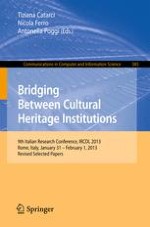2014 | Buch
Bridging Between Cultural Heritage Institutions
9th Italian Research Conference, IRCDL 2013, Rome, Italy, January 31–February 1, 2013, Revised Selected Papers
herausgegeben von: Tiziana Catarci, Nicola Ferro, Antonella Poggi
Verlag: Springer Berlin Heidelberg
Buchreihe : Communications in Computer and Information Science
